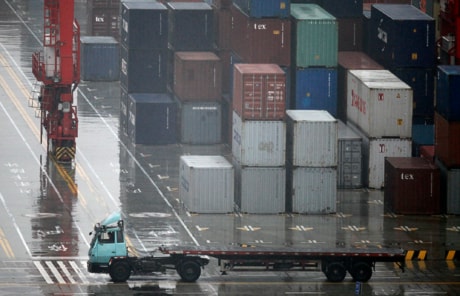SHANGHAI, China — For the first time in six years, China’s imports in March outpaced its exports, leaving a US$7.24 billion shortfall that Beijing says reflects a trend toward more balanced trade but is likely to be short-lived.
Last month’s trade deficit with the rest of the world may buy China some respite from building pressure to revalue its currency, though its surpluses with the United States and Europe remain as robust as ever.
Even if China allows the yuan to gain slightly in value against the dollar in coming weeks, the shift is unlikely to settle the raging debate over whether its currency policy is unfairly distorting trade.
“The calm won’t last. China’s trade surplus will soon reappear. Indeed, the surplus that matters most politically, that with the U.S., is already rising again and not far off a record high,” Mark Williams, senior economist with Capital Economics, said in a report Saturday.
Beijing appeared pleased with the trade data for March, with the commerce minister and others leaking news of the deficit — the first since a $2.26 billion deficit in April 2004 — in advance of Saturday’s announcement by the Customs Administration.
Zheng Yuesheng, chief of the customs agency’s statistics department, said the 60 per cent rise in China’s imports in January-March, compared to a year earlier, was a boon to “the balanced growth of the world economy.”
“This kind of trade deficit is healthy because it appears when exports and imports both grow rapidly,” Zheng said on national television.
Zheng echoed other officials in predicting that China’s trade will soon return to surplus, though he said that it will likely tend to be more balanced than in the past.
Chinese officials contend that raising the yuan’s value would hurt struggling exporters and add uncertainty to a still hazy world economic outlook.
“We are still very much concerned. Global demand is still weak and protectionism is rising,” Chinese Vice Commerce Minister Yi Xiaozhun said at a regional conference, the Boao Forum for Asia, on Saturday.
China’s exports totalled $112.11 billion in March, up 24.3 per cent from a year earlier. Imports reached $119.35 billion, up 66 per cent compared to the same period last year, the Customs Administration said in data posted on its Web site.
In January-March, China still posted a global trade surplus of $14.5 billion, though it fell 76.7 per cent from the same period last year.
The trade surplus was $7.6 billion in February and the combined January-February surplus was $21.8 billion.
The overall March deficit reflects sustained strong demand in China, helped by a torrent of bank lending and other government stimulus, which is driving up prices for imported crude oil, iron ore and other raw materials.
Meanwhile, the Western countries that are China’s main customers for its exports have yet to return to solid growth, though they are expected to revive later this year.
The strongest growth in imports was from suppliers of commodities in the developing world, not from Western industrial trading partners.
China recorded a $9.87 billion trade surplus with the United States in March and a $30.7 billion surplus for the first quarter, the customs figures showed. Imports from the U.S. rose 43 per cent in March, nearly twice the pace of exports.
China’s trade surplus with the European Union was $7 billion in March and $29.3 billion for the first three months of the year.
Persisting trade surpluses have caused U.S. and European leaders to demand that Beijing let the yuan rise in value, thereby raising Chinese purchasing power and perhaps helping create jobs in the West. Some American economists estimate the yuan is undervalued by up to 40 per cent, giving its exporters an unfair advantage and swelling its trade surplus.
Beijing, arguing that a stable currency benefits both Chinese and world economic growth, has kept the value of the yuan tightly linked to the U.S. dollar for much of the past two decades. It loosened that link in 2005, letting the yuan rise about 20 per cent before clamping down in mid-2008 to help staunch the loss of millions of factory jobs due to plunging global demand.
The deficit shows “the decisive factor that affects the trade balance is not the exchange rate, it’s the relationship between market supply and demand and other factors,” the Commerce Ministry said in a separate statement Saturday.
Some U.S. lawmakers have urged President Barack Obama to have China declared a currency manipulator in a Treasury Department report that was due out this month.
Moving to soothe rising tensions, Washington postponed the report ahead of a visit by President Hu Jintao to the U.S. to attend a nuclear conference. Following a brief stopover in Beijing this week by Treasury Secretary Timothy Geithner for talks with Vice Premier Wang Qishan, many expect Beijing to allow at least a modest change in the yuan’s value.
Supporters of loosening controls on the Chinese currency say Beijing’s efforts to keep the yuan’s value steady are fueling inflation and hampering its monetary policy choices.
“China can go a lot further in internationalizing its economy and promoting world growth by making its currency more flexible,” Pieter Bottelier, an economist who formerly headed the World Bank’s Beijing office, told a conference in Shanghai this week.
———
Associated Press researchers Ji Chen in Shanghai and Henry Hou in Beijing contributed to this report.
